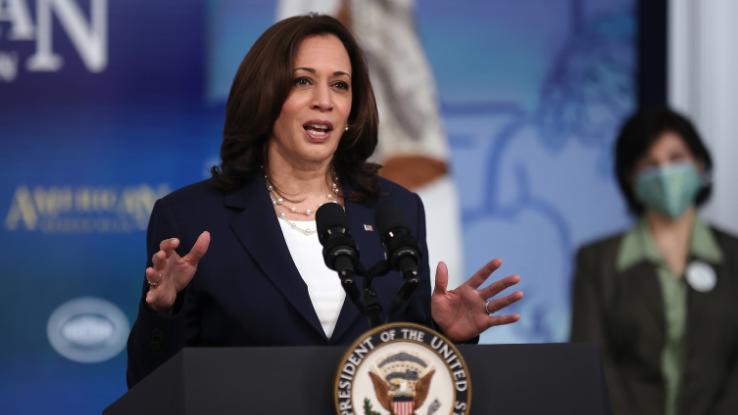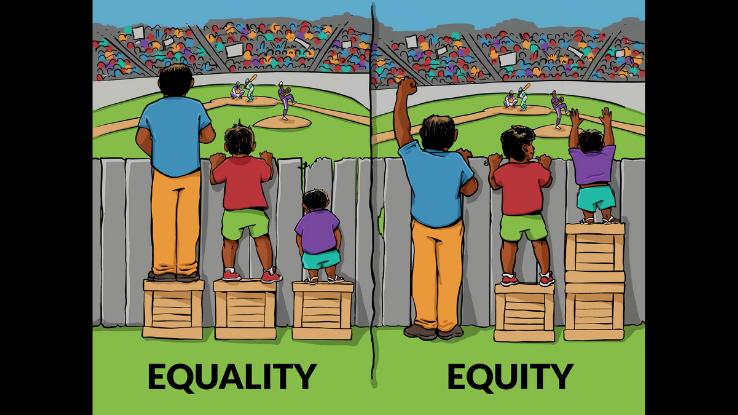
Equality vs. equity — sure, the words share the same etymological roots, but the terms have two distinct, yet interrelated, meanings. Most likely, you’re more familiar with the term “equality” — or the state of being equal. To achieve equality, a sameness of treatment should extend to all people, no matter their gender, race, ability, sexual orientation, class, and/or ethnicity, for example. Moreover, we often align equality with equal rights, access and opportunities in addition to equal treatment.
“Equity,” on the other hand, relates to justice, or proportional fairness. While many of us may think of equity in terms of finances or business — like having equity in a company — it has gained much more traction recently in the realms of social justice, civil rights and politics. In these areas, equity is about providing varying levels of support and assistance to folks in order to level the playing field and, in the end, achieve an equal outcome.
So, why can’t these terms be used interchangeably? Think of it this way: equality relates to sameness of treatment, but that sameness of treatment does not always equate to “proportional fairness,” or equity. Mental Floss puts it simply, noting that “equality has to do with giving everyone the exact same resources, whereas equity involves distributing resources based on the needs of the recipients.”
Equality vs. Equity: The Push for Equity Isn’t New — But It Is Needed Right Now
On an episode of NPR’s On Point, host Meghna Chakrabarti explored the differences between equity and equality in America, a conversation that was sparked, in part, by President Joe Biden’s signing of an Executive Order titled “On Advancing Racial Equity and Support for Underserved Communities Through the Federal Government” back in January 2021.
While equity has been discussed, and while strides toward it have been made in the past, the Biden Administration has made sure to mention the term quite a bit, leaving many Americans to wonder more deeply about the nature of equality vs. equity. Soon after that Executive Order was signed, Vice President Kamala Harris aimed to further clarify the differences between equality and equity — terms that cannot be used interchangeably, but, in practice, should happen side-by-side one another.
“Yes, we want everyone to get an equal amount — that sounds right. But not everyone starts out from the same place. Some people start out on first base. Some people start out on third base,” Vice President Harris explained. “And if the goal is truly about equality, it has to be about a goal of saying everybody should end up in the same place, and, since we didn’t start in the same place, some folks might need more — equitable distribution.”

Chakrabarti delved further into Vice President Harris’ explanation with On Point guest Robert Patterson, a professor of African American Studies at Georgetown University. Professor Patterson notes that it’s difficult to discuss equity without first bringing up equality — and its shortcomings.
“[Equality] doesn’t necessarily account for the present standing that’s sort of based on a history that has impacted where those people are,” Professor Patterson explains on the podcast. “So, when we think of equity, by contrast, we’re thinking about what are the resources that are needed that would account for, to Vice President Harris’ point, different starting points… that would account for the accumulation of wealth… the accumulation of poverty, and how to … prescribe those resources in a way that the outcomes are similar.”
Leveling the Playing Field: Equal vs. Equitable Outcomes, Explained
Created by the Interaction Institute for Social Change and the Center for Story-based Strategy, the below graphic perhaps best illustrates the concept of equality vs. equity. In the image, three people of different heights want to watch a game, only to find a fence obstructing their view. If there are three boxes to distribute, a methodology focused solely on equality would see each person receiving a box, regardless of their starting points (here, their varying heights). The outcome? The shortest person still can’t see the game despite the equal distribution of resources.
However, the equitable distribution of resources accounts for where these people start from. The tallest figure can already see over the obstruction and, therefore, doesn’t need a box, which allows for the other two people to receive the amount of boxes (or resources) they need to see over the fence. The outcome? Although they all have a different amount of resources, all three people can now see over the obstruction and watch the game.

Equality means we all deserve, and should receive, the same access, but, as illustrated above, equity helps to level the playing field to help achieve that outcome, that access. “To summarize,” Mental Floss notes, “equality is about dividing resources in matching amounts, and equity focuses more on dividing resources proportionally to achieve a fair outcome for those involved.”
So, what’s a real-word example of this difference? Thoughtco. frames the difference between equality and equity in a very digestible way. “Laws such as the Civil Rights Act of 1964 provide equality,” the publication notes, “while policies such as affirmative action provide equity.” That is, while the Civil Rights Act advocates for equality and equal treatment, something like affirmative action, an example of equitable distribution, acts as a means of achieving that equality and ensuring a same, or similar, outcome for all peoples, regardless of where they started or how systems historically oppressed and disenfranchised them.
In other words, equality is the outcome — that universal sameness — but equity accounts for the potential need for different access points, so that those runners on first and third, like in Vice President Harris’ analogy, can both make it to home plate.






